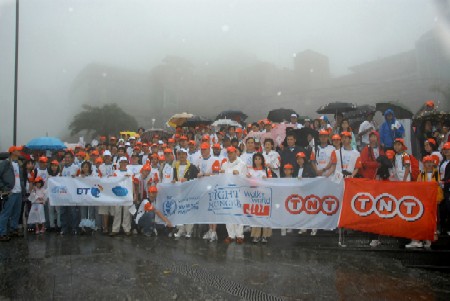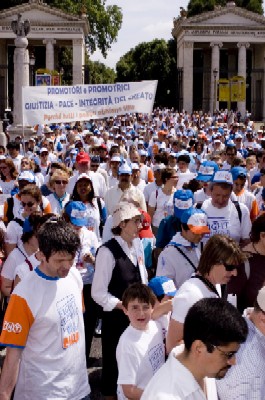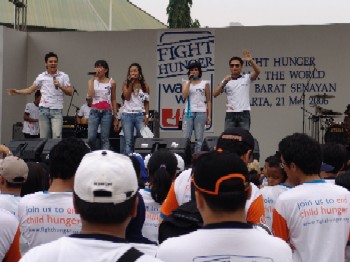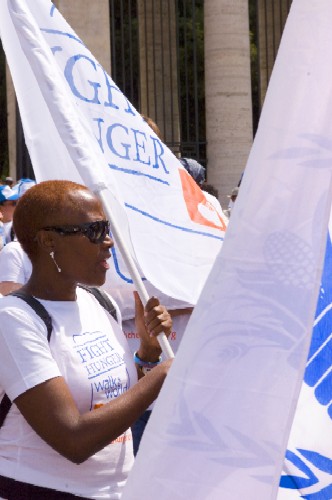Navigation
Over 700,000 People In 118 Countries Walk To Deliver A Message: Child Hunger Has No Place In This World And Citizens Working Together Can Root It Out.
On Sunday 21 May, more than 760.000 people in 118 countries and 420 locations, across 24 time zones, participated in “Fight Hunger: Walk the World.” People came out in force to deliver a message: child hunger has no place in this world and citizens working together can root it out.
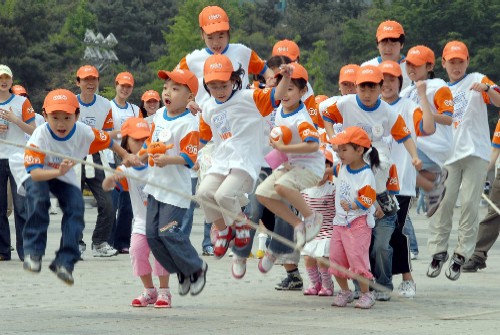 | ||||||||
Children leading the way in Korea Photo by Seoyoung Schin
On Sunday 21 May, more than 760.000 people in 118 countries and 420 locations, across 24 time zones, participated in “Fight Hunger: Walk the World.” People came out in force to deliver a message: child hunger has no place in this world and citizens working together can root it out.
The United Nations World Food Programme (WFP), its humanitarian and corporate partners, political leaders, artists and sport champions, as well as war-displaced families and over 100,000 school children in sub-Saharan Africa alone, stepped forward in fight against child hunger. WFP called the Walk “A Triumphant Step Against Child Hunger.”
From Auckland New Zealand, to Pacific Ocean island of Samoa, people rose up to declare it is unacceptable that 18,000 children die of hunger daily on a planet that produces more than enough to feed every inhabitant.
International capitals, rural communities, neighborhoods and historical landmarks served as the backdrop to walks which varied in size and style. In northern Uganda alone, on a hot and sunny day, more than 100,000 displaced civilians living in camps participated in the Walk. The downpour in London could have caused some problems for Walk the World, but there was no stopping committed walkers led by Princess Haya of Dubai, WFP Goodwill Ambassador.
In the Bolivian capital, La Paz, two brothers were reunited after having been separated for six years. Both are being fed by two separate school feeding programs administered by WFP. Participants in Lesotho had a wonderful time during the 11km Walk in Maseru, which was led by the country's Hon. Queen 'MaSenate Mohato Bereng Seeiso. The President of Liberia Ellen Johnson Sirleaf was at the head of a 30,000-strong crowd through Monrovia that ended in the City Stadium.
In Indonesia, a world champion swimmer set a new world record on behalf of Walk the World by crossing the treacherous Bali straits while other supporters of ending child hunger were planting Walk the World: Fight Hunger flags at Mount Everest and Kilimanjaro summits. The call to end child hunger was heard in Red Square in Moscow, on The Great Wall of China, in the historic centres of Budapest and Prague, in the old cities of Amman and Cairo, and in hundreds of other locations in all continents around the globe.
And in his special Sunday morning address, participants around the world were encouraged when Pope Benedict XVI expressed his support for the Fight Hunger: Walk the World initiative to end child hunger by 2015.
"If we ignore child hunger, it remains a daily reality that ravages millions and goes unseen by most. We are bringing this otherwise invisible problem into the spotlight and moving citizens and governments to action," said Arlene Mitchell, WFP Director of Walk the World. "There is no excuse for children to be chronically hungry, day in and day out in the 21st century. The world community still has to make a huge progress in order to improve the lives of children. Fight Hunger: Walk the World makes a step forward on the path."
"The event, initiated three years ago by TNT, global provider of express, mail and logistics services, aims to engage citizens worldwide, throughout the next decade to achieve the Millennium Development Goal of halving the proportion of hungry people globally by 2015," said Mitchell. "Without citizen action, the status quo will remain. But with it, the world can help to end the unnecessary suffering of children."
The cash raised through the walk (the final tally is being calculated) will fund two successful global activities aimed at reducing child hunger: projects to help pregnant and lactating women and young children and school feeding projects which provide food for school students in developing countries.
Last year, WFP provided school meals for 21.7 million children in 74 countries. The Programme plans to reach 50 million schoolchildren by 2008. All too often pupils, particularly girls, are deprived of education because their families cannot afford to send them to school. Yet educating girls is one of the best ways of permanently escaping the vicious cycle of poverty, illiteracy, poor health and hunger.
WFP is the world's largest humanitarian agency: “Each year, we give food to an average of 90 million poor people to meet their nutritional needs, including 61 million hungry children, in at least 80 of the world's poorest countries. WFP -- We Feed People.”
WFP Global School Feeding Campaign, For just 19 US cents a day, you can help WFP give children in poor countries a healthy meal at school, a gift of hope for a brighter future.
The WFP is solely responsible for the contents of this article. www.wfp.org
Contacts:
For more information please contact: Ramin Rafirasme, Event Coordinator, WFP/Rome, Tel. +39-06-65132684, Cell. +39-335-8432961
Brenda Barton, Deputy Director of Communications, WFP/Rome, Tel. +39-06-65132602, Cell. +39-3472582217
Christiane Berthiaume, WFP/Geneva, Tel. +41-22-9178564, Cell. +41-792857304
Trevor Rowe, WFP/New York, Tel. +1-212-9635196, Cell. +1-6468241112,
Gregory Barrow, WFP/London, Tel. +44-20-72409001, Cell. +44-7968-008474
Jennifer Parmelee, WFP/Washington, Tel. +1-202-6530010 ext. 1149, Cell: +1-202-4223383
Bettina Luescher, WFP/Berlin, Tel. +49-30-20614912, Cell. +49-170-9039479
|
Search
Latest articles
Agriculture
- World Water Week: Healthy ecosystems essential to human health: from coronavirus to malnutrition Online session Wednesday 24 August 17:00-18:20
- World Water Week: Healthy ecosystems essential to human health: from coronavirus to malnutrition Online session Wednesday 24 August 17:00-18:20
Air Pollution
- "Water and Sanitation-Related Diseases and the Changing Environment: Challenges, Interventions, and Preventive Measures" Volume 2 Is Now Available
- Global Innovation Exchange Co-Created by Horizon International, USAID, Bill and Melinda Gates Foundation and Others
Biodiversity
- It is time for international mobilization against climate change
- World Water Week: Healthy ecosystems essential to human health: from coronavirus to malnutrition Online session Wednesday 24 August 17:00-18:20
Desertification
- World Water Week: Healthy ecosystems essential to human health: from coronavirus to malnutrition Online session Wednesday 24 August 17:00-18:20
- UN Food Systems Summit Receives Over 1,200 Ideas to Help Meet Sustainable Development Goals
Endangered Species
- Mangrove Action Project Collaborates to Restore and Preserve Mangrove Ecosystems
- Coral Research in Palau offers a “Glimmer of Hope”
Energy
- Global Innovation Exchange Co-Created by Horizon International, USAID, Bill and Melinda Gates Foundation and Others
- Wildlife Preservation in Southeast Nova Scotia
Exhibits
- Global Innovation Exchange Co-Created by Horizon International, USAID, Bill and Melinda Gates Foundation and Others
- Coral Reefs
Forests
- NASA Satellites Reveal Major Shifts in Global Freshwater Updated June 2020
- Global Innovation Exchange Co-Created by Horizon International, USAID, Bill and Melinda Gates Foundation and Others
Global Climate Change
- It is time for international mobilization against climate change
- It is time for international mobilization against climate change
Global Health
- World Water Week: Healthy ecosystems essential to human health: from coronavirus to malnutrition Online session Wednesday 24 August 17:00-18:20
- More than 400 schoolgirls, family and teachers rescued from Afghanistan by small coalition
Industry
- "Water and Sanitation-Related Diseases and the Changing Environment: Challenges, Interventions, and Preventive Measures" Volume 2 Is Now Available
- Global Innovation Exchange Co-Created by Horizon International, USAID, Bill and Melinda Gates Foundation and Others
Natural Disaster Relief
- STOP ATTACKS ON HEALTH CARE IN UKRAINE
- Global Innovation Exchange Co-Created by Horizon International, USAID, Bill and Melinda Gates Foundation and Others
News and Special Reports
- World Water Week: Healthy ecosystems essential to human health: from coronavirus to malnutrition Online session Wednesday 24 August 17:00-18:20
- STOP ATTACKS ON HEALTH CARE IN UKRAINE
Oceans, Coral Reefs
- World Water Week: Healthy ecosystems essential to human health: from coronavirus to malnutrition Online session Wednesday 24 August 17:00-18:20
- Mangrove Action Project Collaborates to Restore and Preserve Mangrove Ecosystems
Pollution
- Zakaria Ouedraogo of Burkina Faso Produces Film “Nzoue Fiyen: Water Not Drinkable”
- "Water and Sanitation-Related Diseases and the Changing Environment: Challenges, Interventions, and Preventive Measures" Volume 2 Is Now Available
Population
- "Water and Sanitation-Related Diseases and the Changing Environment: Challenges, Interventions, and Preventive Measures" Volume 2 Is Now Available
- "Water and Sanitation-Related Diseases and the Changing Environment: Challenges, Interventions, and Preventive Measures" Volume 2 Is Now Available
Public Health
- Honouring the visionary behind India’s sanitation revolution
- Honouring the visionary behind India’s sanitation revolution
Rivers
- World Water Week: Healthy ecosystems essential to human health: from coronavirus to malnutrition Online session Wednesday 24 August 17:00-18:20
- Mangrove Action Project Collaborates to Restore and Preserve Mangrove Ecosystems
Sanitation
- Honouring the visionary behind India’s sanitation revolution
- Honouring the visionary behind India’s sanitation revolution
Toxic Chemicals
- "Water and Sanitation-Related Diseases and the Changing Environment: Challenges, Interventions, and Preventive Measures" Volume 2 Is Now Available
- Actions to Prevent Polluted Drinking Water in the United States
Transportation
- "Water and Sanitation-Related Diseases and the Changing Environment: Challenges, Interventions, and Preventive Measures" Volume 2 Is Now Available
- Urbanization Provides Opportunities for Transition to a Green Economy, Says New Report
Waste Management
- Honouring the visionary behind India’s sanitation revolution
- Honouring the visionary behind India’s sanitation revolution
Water
- Honouring the visionary behind India’s sanitation revolution
- Honouring the visionary behind India’s sanitation revolution
Water and Sanitation
- Honouring the visionary behind India’s sanitation revolution
- Honouring the visionary behind India’s sanitation revolution

